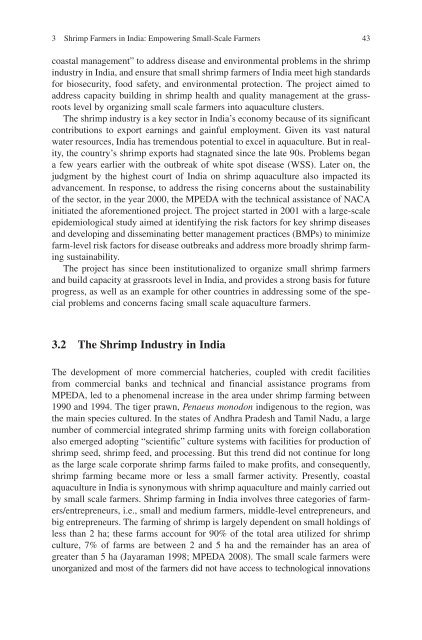Success Stories In Asian Aquaculture - Library - Network of ...
Success Stories In Asian Aquaculture - Library - Network of ...
Success Stories In Asian Aquaculture - Library - Network of ...
- No tags were found...
You also want an ePaper? Increase the reach of your titles
YUMPU automatically turns print PDFs into web optimized ePapers that Google loves.
3 Shrimp Farmers in <strong>In</strong>dia: Empowering Small-Scale Farmers43coastal management” to address disease and environmental problems in the shrimpindustry in <strong>In</strong>dia, and ensure that small shrimp farmers <strong>of</strong> <strong>In</strong>dia meet high standardsfor biosecurity, food safety, and environmental protection. The project aimed toaddress capacity building in shrimp health and quality management at the grassrootslevel by organizing small scale farmers into aquaculture clusters.The shrimp industry is a key sector in <strong>In</strong>dia’s economy because <strong>of</strong> its significantcontributions to export earnings and gainful employment. Given its vast naturalwater resources, <strong>In</strong>dia has tremendous potential to excel in aquaculture. But in reality,the country’s shrimp exports had stagnated since the late 90s. Problems begana few years earlier with the outbreak <strong>of</strong> white spot disease (WSS). Later on, thejudgment by the highest court <strong>of</strong> <strong>In</strong>dia on shrimp aquaculture also impacted itsadvancement. <strong>In</strong> response, to address the rising concerns about the sustainability<strong>of</strong> the sector, in the year 2000, the MPEDA with the technical assistance <strong>of</strong> NACAinitiated the aforementioned project. The project started in 2001 with a large-scaleepidemiological study aimed at identifying the risk factors for key shrimp diseasesand developing and disseminating better management practices (BMPs) to minimizefarm-level risk factors for disease outbreaks and address more broadly shrimp farmingsustainability.The project has since been institutionalized to organize small shrimp farmersand build capacity at grassroots level in <strong>In</strong>dia, and provides a strong basis for futureprogress, as well as an example for other countries in addressing some <strong>of</strong> the specialproblems and concerns facing small scale aquaculture farmers.3.2 The Shrimp <strong>In</strong>dustry in <strong>In</strong>diaThe development <strong>of</strong> more commercial hatcheries, coupled with credit facilitiesfrom commercial banks and technical and financial assistance programs fromMPEDA, led to a phenomenal increase in the area under shrimp farming between1990 and 1994. The tiger prawn, Penaeus monodon indigenous to the region, wasthe main species cultured. <strong>In</strong> the states <strong>of</strong> Andhra Pradesh and Tamil Nadu, a largenumber <strong>of</strong> commercial integrated shrimp farming units with foreign collaborationalso emerged adopting “scientific” culture systems with facilities for production <strong>of</strong>shrimp seed, shrimp feed, and processing. But this trend did not continue for longas the large scale corporate shrimp farms failed to make pr<strong>of</strong>its, and consequently,shrimp farming became more or less a small farmer activity. Presently, coastalaquaculture in <strong>In</strong>dia is synonymous with shrimp aquaculture and mainly carried outby small scale farmers. Shrimp farming in <strong>In</strong>dia involves three categories <strong>of</strong> farmers/entrepreneurs,i.e., small and medium farmers, middle-level entrepreneurs, andbig entrepreneurs. The farming <strong>of</strong> shrimp is largely dependent on small holdings <strong>of</strong>less than 2 ha; these farms account for 90% <strong>of</strong> the total area utilized for shrimpculture, 7% <strong>of</strong> farms are between 2 and 5 ha and the remainder has an area <strong>of</strong>greater than 5 ha (Jayaraman 1998 ; MPEDA 2008) . The small scale farmers wereunorganized and most <strong>of</strong> the farmers did not have access to technological innovations
















